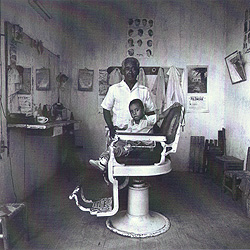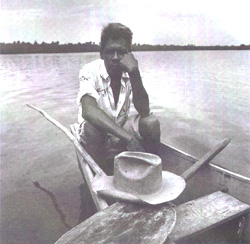 
Africa's Legacy in
Mexico
A Legacy of Slavery
|

"Barber Shop," Pinotepa
Nacional, Oaxaca, Mexico, 1990
A LEGACY OF SLAVERY
Colin A. Palmer
When I arrived in Mexico about two decades
ago to begin research on the early history of Africans and their descendants
there, a young student politely told me that I was embarking on a wild goose
chase. Mexico had never imported slaves from Africa, he said, fully certain
that the nation's peoples of African descent were relatively recent arrivals.
This lack of knowledge about Mexico's African peoples has not changed
much over time. A short while ago a Mexican engineer, himself of African
descent, told me adamantly that the country's blacks were the descendants
of escaped slaves from North America and Cuba. These fugitives, he proudly
proclaimed, had sought and found sanctuary in free Mexico.
The historical record, of course, tells another story. In the sixteenth
century, New Spain--as Mexico was then called--probably had more enslaved
Africans than any other colony in the Western Hemisphere. Blacks were present
as slaves of the Spaniards as early as the 1520s. Over the approximately
three hundred years it lasted, the slave trade brought about 200,000 Africans
to the colony. Many blacks were born in Mexico and followed their parents
into slavery. Not until 1829 was the institution abolished by the leaders
of the newly independent nation.

"Man & Canoe," Corralero,
Oaxaca, Mexico, 1987
African labor was vital to the Spanish colonists. As indigenous peoples
were killed or died from European diseases, blacks assumed a disproportionate
share of the burden of work, particularly in the early colonial period.
African slaves labored in the silver mines of Zacatecas, Taxco, Guanajuato,
and Pachuca in the northern and central regions; on the sugar plantations
of the Valle de Orizaba and Morelos in the south; in the textile factories
("obrajes") of Puebla and Oaxaca on the west coast and in Mexico
City; and in households everywhere. Others worked in skilled trade or on
cattle ranches. Although black slaves were never more than two percent of
the total population, their contributions to colonial Mexico were enormous,
especially during acute labor shortages.
Wherever their numbers permitted, slaves created networks that allowed
them to cope with their situation, give expression to their humanity, and
maintain a sense of self. These networks flourished in Mexico City, the
port city of Veracruz, the major mining centers, and the sugar plantations,
allowing Africans to preserve some of their cultural heritage even as they
forged new and dynamic relationships. Although males outnumbered females,
many slaves found spouses from their own or other African ethnic groups.
Other slaves married or had amorous liaisons with the indigenous peoples
and to a lesser extent the Spaniards. In time, a population of mixed bloods
emerged, gaining demographic ascendancy by the mid-eighteenth century. Known
as "mulattos," "pardos," or "zambos," many
of them were either born free or in time acquired their liberty.
As in the rest of the Americas, slavery in Mexico exacted a severe physical
and psychological price from its victims. Abuse was a constant part of a
slave's existence; resisting oppression often meant torture, mutilation,
whipping, or being put in confinement. Death rates were high, especially
for slaves in the silver mines and on the sugar plantations. Yet, for the
most part, their spirits were never broken and many fled to establish settlements
("palenques") in remote areas of the country.
These fugitives were a constant thorn in the side of slave owners. The
most renowned group of "maroons," as they were called, escaped
to the mountains near Veracruz. Unable to defeat these intrepid Africans,
the colonists finally recognized their freedom and allowed them to build
and administer their own town. Today, their leader, Yanga, remains a symbol
of black resistance in Mexico.
Other slaves rebelled or conspired to. The first conspiracy on record
took place in 1537, and these assaults on the system grew more frequent
as the black population increased.
Regardless of the form it took--escape or rebellion--resistance demonstrated
an angry defiance of the status quo and the slaves' desire to reclaim their
own lives. As such, black resistance occupies a special place in Mexico's
revolutionary tradition, a tradition that is a source of pride for many
Mexicans.
Beyond that, Africans in Mexico left their cultural and genetic imprint
everywhere they lived. In states such as Veracruz, Guerrero, and Oaxaca,
the descendants of Africa's children still bear the evidence of their ancestry.
No longer do they see themselves as Mandinga, Wolof, Ibo, Bakongo, or members
of other African ethnic groups; their self identity is Mexican, and they
share much with other members of their nation-state.
Yet their cultural heritage has not entirely disappeared. Some African
traditions survive in song, music, dance, and other ways. But much has changed
since slavery ended, and it is difficult for a small minority to maintain
its traditions in a constantly changing society.
As their ancestors did, the few remaining persons who are visibly of
African descent continue to be productive members of society. But history
has not been kind to the achievements of African peoples in Mexico. It is
only within recent times that their lives have been studied and their contributions
to Mexican society illuminated. Suffice it to say that contemporary black
Mexicans can claim this proud legacy and draw strength from it, even as
they become a shrinking part of their country's peoples.

|